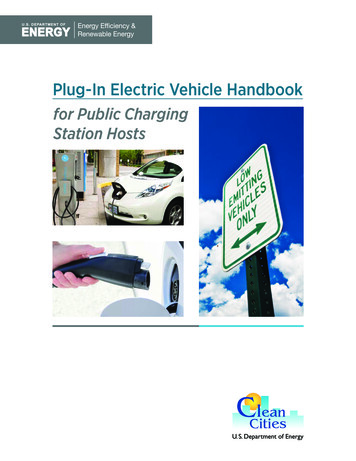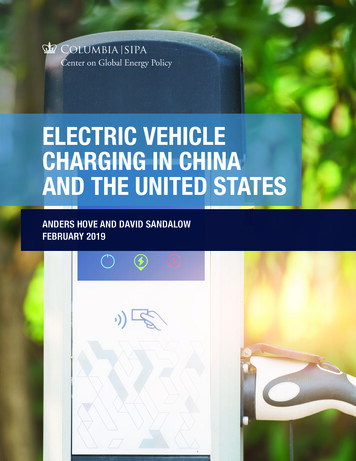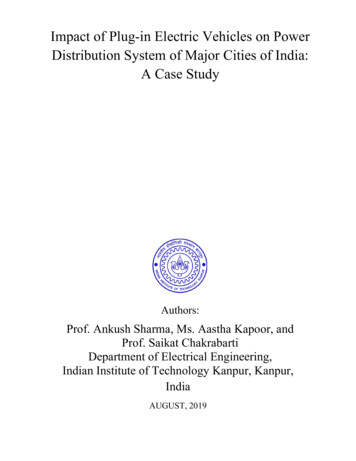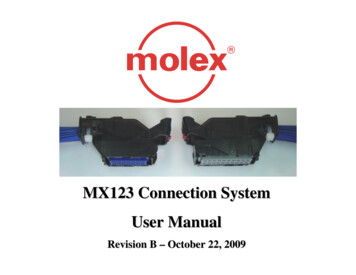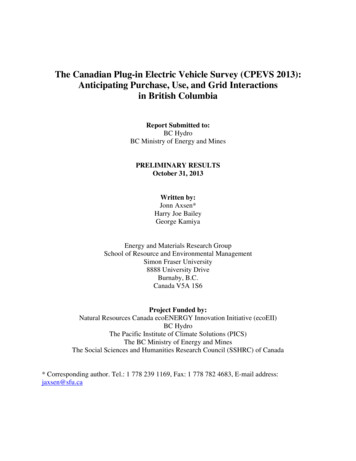
Transcription
The Canadian Plug-in Electric Vehicle Survey (CPEVS 2013):Anticipating Purchase, Use, and Grid Interactionsin British ColumbiaReport Submitted to:BC HydroBC Ministry of Energy and MinesPRELIMINARY RESULTSOctober 31, 2013Written by:Jonn Axsen*Harry Joe BaileyGeorge KamiyaEnergy and Materials Research GroupSchool of Resource and Environmental ManagementSimon Fraser University8888 University DriveBurnaby, B.C.Canada V5A 1S6Project Funded by:Natural Resources Canada ecoENERGY Innovation Initiative (ecoEII)BC HydroThe Pacific Institute of Climate Solutions (PICS)The BC Ministry of Energy and MinesThe Social Sciences and Humanities Research Council (SSHRC) of Canada* Corresponding author. Tel.: 1 778 239 1169, Fax: 1 778 782 4683, E-mail address:jaxsen@sfu.ca
AbstractThis report investigates consumer interest in plug-in electric vehicles (PEVs), summarizingpreliminary results from the Canadian PEV Survey (CPEVS 2013). Between April and October2013, 1,754 new vehicle buying Canadian households completed this survey, including 538residents of British Columbia (BC). This three-part survey collected in-depth information fromeach respondent, including: background information such as vehicle ownership, electricity use,familiarity with PEV technology, and personal values and lifestyle; vehicle travel behaviour;access to vehicle charging at home and elsewhere; interest in purchasing a PEV under differentconditions; interest in green electricity; and openness to enrolling in a utility controlled charging(UCC) program to increase the uptake of intermittent renewable energy sources. This reportsummarizes several preliminary results for the BC sample:1. Many BC new-vehicle buyers have recharge access at home.2. Most BC new-vehicle buyers have little awareness of PEVs.3. BC new-vehicle buyers are much more likely to want a plug-in hybrid (PHEV) than a“pure” electric vehicle (EV).4. The potential “early mainstream” PEV buyers in BC are unique in terms of homerecharge access, age, household size and lifestyle5. There are three different lifestyle segments of potential “early mainstream” PEV buyersin BC (differing by engagement in environment- and technology-oriented lifestyles).6. Without incentives or policy to control recharge behaviour, PEV electricity demand willlikely peak at around 6pm each day.7. Potential “early mainstream” PEV buyers are generally open to the idea of “utilitycontrolled charging” to support renewables—despite some privacy concerns.i
Executive SummaryStudy OverviewElectric-mobility may be a key component in a successful societal transition toward deepgreenhouse-house (GHG) reductions (Williams et al., 2012). This report considers the potentialmarket for plug-in electric vehicles (PEVs) in Canada’s passenger (light-duty) vehicle sector. Weconsider two broad categories of PEVs: Plug-in hybrid electric vehicles (PHEVs) that can bepowered by grid electricity for an initial distance, say 60 km, but are otherwise powered bygasoline until the battery is recharged (e.g. the Chevrolet Volt) and Electric vehicles (EVs) thatare powered solely by electricity for a range of 100 to 300 km (e.g. the Nissan LEAF).Widespread uptake and use of passenger PEVs will involve meaningful shifts in social andtechnical systems (Sovacool and Hirsh, 2009). To investigate how consumer interest in PEVsmay guide such shifts, we engage a sample of Canadian new car buyers in a mixed-mode surveyprocess. Data were collected via the Canadian Plug-in Electric Vehicle Survey (CPEVS 2013).We presently focus on British Columbia (BC) data, but note that CPEVS 2013 includes datafrom other Canadian provinces with oversamples of Alberta and Ontario new vehicle buyinghouseholds. This preliminary research report addresses the following objectives for the BCsample:1. Characterize new vehicle buyers’ travel patterns and recharge access, including Level 1(110/120-V) and Level 2 (220/240-V) access.2. Identify the potential “early mainstream” PEV market according to vehicle designinterests and demographic and lifestyle characteristics.3. Anticipate the potential usage patterns (travel and charging) of the “potential earlymainstream” PEV market.4. Assess consumer acceptance of “utility controlled charging” (UCC) as a potential meansto power PEVs with intermittent, renewable electricity sources.MethodPrevious PEV market research can be categorized into three approaches: constraints analyses,rational-actor choice models, and the reflexive lifestyle approach. The CPEV 2013 surveyfollows the reflexive lifestyle approach, which assumes that consumers construct their interestsand preferences as they learn about PEV technology, and that these interests may or may not beconstrained by present driving patterns and home recharge access—depending on themotivations of the consumer. Our target population is new vehicle buying households in Canada,from which we seek to identify the potential “early mainstream” PEV buyers. This is a muchlarger segment than the initial “pioneer” segment of initial PEV buyers (e.g. present PEVowners), and generally has characteristics more in line with mainstream consumer values andinterests. PEVs must be accepted by this market in order to become a widely used technology.CPEVS 2013 is a three-part survey that elicits many details about the respondent (Part 1), thenprovides respondents with opportunities to learn about their own interest in PEVs and how thetechnology may relate to their lifestyle (Part 2), and finally elicits respondent interest in buying aPEV and how they may recharge it under various conditions (Part 3). The overall flow of thethree-part survey is depicted in Figure E-1.ii
Figure E-1: Summary of CPEVS 2013 three-part method and potential outputsSampleSentis Market Research was hired to recruit survey respondents for CPEVS 2013. Screener datawas collected to ensure that the realized sample would match the target population (new vehiclebuying households) in terms of basic demographic information (e.g. age and gender). In total,1754 respondents completed all three parts of the survey, with 538 respondents from BC (FigureE-2). The full Canadian sample includes all provinces except for Quebec. Comparing the BCsample to the corresponding Census data, we find that the recruited sample is generallyrepresentative of new car buyers, which are typically older, of higher income, more highlyeducated, and more likely to own their own home, relative to the general population.iii
Figure E-2: Geographical representation of BC survey sample by postal code (n 538)ResultsThrough preliminary analysis of CPEVS 2013 data for BC, we have teased out seven initialresults presented in this report.RESULT #1: Many BC consumers have recharge access at homeIn Part 2 of CPEVS 2013, respondents conducted a home recharge assessment where theylocated electrical outlets and panels near their typical parking locations at home. We find that66% of BC respondents currently have Level 1 access at home (parking within 25 feet or 8 m ofan existing 110/120-V outlet), and 19% have Level 2 access at home (parking with 25 feet or 8m of an existing 220/240-V outlet). Level 1 and Level 2 access vary across respondents based onhousing type, and parking space type (Figure E-3). Only about half of the 19% with existingLevel 2 access reported that they would regularly use it to charge a PEV. A further 35% alsohave the potential to install Level 2, where our estimated installation prices would range from 1,000 to 3,500 (depending on household infrastructure).iv
Figure E-3: Respondents’ residential Level 1 and 2 access by housing type andparking space (BC only, n 528)Figure E-4 depicts BC respondents’ driving activity and recharge access by time of day andparking location. Presently, the majority of respondents’ charging opportunities are Level 1outlets at their homes. Very few existing Level 2 PEV charging stations were observed atparking locations during the course of respondents’ driving diaries. “Other” parking locationsinclude parking at shopping centres, community centres, and other public parking locations.Figure E-4: Recharge access by time of day (BC only, n 528, 3-day driving diary)v
RESULT #2: Most BC consumers have little awareness of PEVsWe assess respondents’ awareness of PEVs prior to their completion of the PEV “design space”portion of the survey. Respondents first state their familiarity with different vehicle models: ahybrid vehicle (the Toyota Prius), a plug-in hybrid (the Chevrolet Volt), and a pure electricvehicle (the Nissan Leaf). Most respondents are at least somewhat familiar with the Prius (78%),and less familiar with the Chevrolet Volt (55%). The majority are not at all familiar with theNissan LEAF (63%). We also ask respondents how they think each of these vehicle models canbe fueled (Figure E-5): either with gasoline only, electricity only, or both. The majority ofrespondents are fairly confused about the basic function of each vehicle model. Only 18%successfully answer that the Prius can be fueled only by gasoline, and about a third successfullydescribe the fueling capabilities of the Volt and Leaf. This lack of prior knowledge andfamiliarity suggests that consumer perceptions of PEVs are still largely unformed.Figure E-5: Vehicle buyer perceptions of three vehicle models and how they arefueled – “How do you think each of the following vehicles can be fueled?” (BConly, n 538)RESULT #3: BC consumers are much more likely to want a plug-inhybrid (PHEV) than a “pure” electric vehicle (EV).In Part 3 of the CPEVS 2013, respondents indicate their interest in purchasing various PEVdesigns. Respondents were first given a basic education in the different types of vehiclesavailable (hybrid, PHEV and EV). Following this education, the “design space” exercise allowedrespondents to select a conventional gasoline vehicle as a base, then potentially design and selecta hybrid, PHEV or EV version of that base vehicle. Two price scenarios were presented: a higherprice scenario (reflecting current prices) and a lower price scenario (reflecting subsidies or lowerbattery costs).Figure E-6 portrays the distribution of designs selected by respondents. In both price scenarios,the highest proportion of respondents designed and selected some form of HEV (40 to 38vi
percent), with minorities selecting a PHEV (28 to 36 percent) or a conventional vehicle (28 to 21percent). An EV was designed by only two to four percent of survey respondents. Thisgravitation of respondents to PHEV designs (not EV designs) has been seen in previous surveysof U.S. new vehicle buyers. Respondent interest in PEVs is influenced by price (or subsidies);demand for PHEVs in the lower price scenario is 30% higher relative to the higher pricescenario, and interest in EVs doubles (but remains relatively low).Figure E-6: PEV designs selected by BC respondents (BC only, n 442, higherand lower price scenarios)RESULT #4: The potential “early mainstream” PEV buyers are uniquein terms of home recharge access, age, household size and lifestyle.Based on responses to the PEV design space exercises, we identified the potential “earlymainstream” PEV market as reflected by those respondents that designed some form of PHEV orEV in the lower price scenario (40% of the total BC sample, or n 213). We call this thepotential “early mainstream” PEV segment. Using logistic regression analysis we find thatrespondents in the “early mainstream” PEV segment differ from “non-PEV designers” in thefollowing ways: Recharge access: the “early mainstream” PEV segment is more likely to identifyexisting Level 1 access at their home, or to identify the potential to install Level 2 at theirhome. Lifestyle: the “early mainstream” is more likely to engage in environmental-orientedactivities, technology-oriented activities, or spiritual-oriented activities, and less likely toengage in political activities.vii
Demographics: the “early mainstream” is more likely to be younger, and to have morehousehold members.Interestingly, we found that a number of other variables do not appear to be statistically relatedto respondent interest in PEVs. For example, there was no significant association between PEVinterest and household income, travel patterns (distance per day of frequency of trips in thedriving diary), individual values (e.g. biospheric, altruistic or egoistic values), awareness of apublic charger, education level, perceptions of climate change, or region. We also compared thelifestyle engagement of respondents by their selected vehicle design (Figure E-7). Respondentsthat selected an EV design (only 4% of the total sample) are most likely to engage in technologyoriented lifestyles, and have about the same engagement in environment-oriented lifestyles asrespondents that designed a PHEV.Figure E-7: Comparing respondent designs (conventional, hybrid, plug-in hybridor electric) by the respondent’s lifestyle (BC only, n 538)RESULT #5: There are three different lifestyle segments of potential“early mainstream” PEV buyers in BC.To provide a more in-depth assessment of the different motives behind potential PEV buyers, weidentify different “early mainstream” segments. We conduct a cluster analysis of theserespondents based on three lifestyle variables: engagement in technology-oriented andenvironment-oriented lifestyles, and lifestyle openness (or liminality). Figure E-8 depicts thethree identified lifestyle-based segments: “low-tech environmental,” “active environmental,”and “technology-oriented.”viii
Figure E-8: Comparing “early mainstream” PEV buyer segments by lifestyle (BConly, n 538)These three “early mainstream” segments differ according to several other characteristics:1. Respondents in the “technology-oriented” cluster: are least likely to be female (45%); have the highest familiarity with the Toyota Prius, Chevrolet Volt, and NissanLeaf; are likely to perceive a variety of PEV information sources as important includingmagazines, news providers, car dealers, TV, research and government; and are the most likely to have “egoistic” values which reflect an interest in wealthand personal gain.2. Respondents in the “active environmental” cluster: are most likely to be female (82%); are most likely to have bachelor’s or graduate degrees; have the highest biospheric and altruistic values; are the most likely to engage in recreation activities and to follow politics andnews sources; are most likely to see climate change and air pollution as “serious” threats; are most likely to think about the environmental impacts of their electricity use; are most likely to be willing to pay extra to support renewable electricity; and are also likely to see a variety of PEV information sources as important, includingnews providers, car dealers, research and government.3. Respondents in the “low-tech environmental” cluster:ix
tend to have the lowest education level;have the lowest level of openness to change (liminality);have a slightly higher pro-environmental attitude than the tech-oriented cluster;are the least likely to engage in a recreational lifestyle, or to follow news andpolitics;are the least likely to be familiar with the Prius, Volt or Leaf;are the least likely to perceive any PEV information sources as important;are more likely than the tech cluster to consider air pollution to be serious.RESULT #6: Without incentives or policy to control rechargebehaviour, PEV electricity demand will likely peak at around 6pm eachday.By matching “early mainstream” respondent’s selected PEV design to their three-day drivingdiary data (temporal driving patterns and recharge potential), we modeled the potential PEVusage patterns of “early mainstream” buyers in BC. Figure E-9 portrays three PEV usagescenarios in terms of kW demanded per PEV across a 24 hour period:1. User informed: representing respondents’ selected PEV designs, driving behavior, andpresent recharge access.2. User Enhanced workplace: same as scenario #1, but with enhanced workplacerecharge access (i.e. assuming Level 2 access is universally available at all workplaces).3. EV-240: using respondents’ driving data, but assuming each “early mainstream”respondent is driving an electric vehicle with 240 km of range (EV-240), and that Level 2recharge access is universally available at all PEV buyers’ homes and workplaces.Figure E-9: PEV electricity usage under different scenarios (“early mainstream”PEV buyers in BC, n 202 respondents, n 606 diary days, 1-minute intervals)x
Scenarios 1 and 2 follow similar electricity demand profiles in the afternoon and evening, whileScenario 3 produces a larger demand spike. Due to enhanced workplace access, Scenarios 2 and3 have an extra peak in the morning around 8:30am, when many drivers arrive at work and canplug in to recharge. Due to increased charging during the day, more driving is diverted to electricpowered driving in Scenario 2, reducing gasoline consumption overall. We did not see any largedifferences in expected PEV load patterns between weekdays and weekends.RESULT #7: Early mainstream PEV buyers are generally open to theidea of “utility controlled charging” to support renewables—despitesome privacy concern.The survey also assessed respondent interest in green electricity and PEV charging behaviourthrough several survey questions and exercises. Regarding electricity sources, respondents aremost likely to support solar, wind, geothermal and run-or-river sources (in that order) and leastlikely to support coal and nuclear sources. The survey also assessed potential consumeracceptance of utility controlled charging (UCC)—where the electric utility could control thetiming of nightly PEV charging in order to better utilize intermittent renewable electricitysources. After providing a simple explanation of UCC to respondents, we elicited respondentperceptions of UCC (Figure E-10). About two-thirds of respondents believe that UCC could helpthe environment and just over half believe that UCC should be supported by the government.Respondents are equally split between support and opposition when asked if UCC should bemandatory for PEV drivers, while about one-third perceive UCC as a potential invasion ofprivacy. We also find that the majority of respondents are willing to sacrifice some PEVcharging overnight (resulting in less than a full charge on some mornings) in order to supportUCC—either to reduce their electrical bill or to support grid uptake of renewables.Figure E-10: Perceptions of “utility controlled charging” as indicated byagreement with several statements (BC, n 442).xi
Next steps in analysis of CPEVS 2013Results presented in this report are preliminary, as of October 31, 2013. We will extend much ofthe present analysis to other Canadian regions, including the Alberta and Ontario samples.Regional comparisons (e.g. BC vs. AB vs. ON) could then be made regarding: travel patterns,residential recharge access, PEV interest, characterizing and segmenting the “early mainstream”PEV buyers, recharge profiles and interest in green electricity and utility controlled charging.Next steps in analysis using the BC and Canadian data may include: Developing more sophisticated discrete choice models of PEV demand. For example, alatent-class approach may be used to identify heterogeneity in consumer valuation ofPEVs, fuel savings, recharge access and electric-powered driving range. Using insights from “design space” exercises and discrete choice models to constructPEV market share forecasts based on different market conditions (e.g. policy, batteryprices, and gasoline and electricity prices). Constructing recharge profiles for a variety of PEV usage scenarios, including differentassumptions about adoption rates and PEV design preferences, access to rechargeinfrastructure, time-of-use electricity rates, and implementation of a utility-controlledcharging (UCC) scheme to optimize the usage of intermittent renewable sources ofelectricity for PEVs. Using respondent travel diary data to construct spatial models to assess the potentialimportance and usage of non-home charging infrastructure.There are several other components to the “consumer research” portion of this broader projectsponsored by Natural Resources Canada’s ecoEnergy Innovation Initiative (ecoEII). Specifically,Dr. Axsen is leading three more consumer components to this project:1. Interviews of BC new vehicle buyers: From the 538 BC respondents that completed theCPEVS 2013 survey, we are selecting diverse subset of 30 to 40 survey respondents toconduct 2-hour household interviews. Households were selected to provide a diversesubsample in terms of region (within different parts of Metro Vancouver), age, income,education, household size, and lifestyle (e.g. engagement in environmental- ortechnology-oriented activities). As of October 2013, 18 households have beeninterviewed.2. Survey of BC PEV owners: The overall CPEVS survey format will be adapted, creatinga version for BC households that presently own some type of PEV. Additional questionswill assess motives for purchase, and levels of satisfaction with the vehicle. A drivingdiary will collect data on driving and recharge patterns for the PEV. The survey willlikely be launched by the spring of 2014, with the goal of recruiting at least 100 PEVowning households for completion over the following year.3. Interviews with BC PEV owners: To complement the PEV owner survey above, weplan to select a subset of survey respondents to complete household interviews. Theseinterviews will address many of the same topics as the more general “new vehicle buyer”interviews, while also addressing issues more specific to PEV buyers (e.g. experiencewith residential and non-home charging infrastructure). Interviews will likely becompleted by the end of 2014.xii
Table of ContentsAbstract . iExecutive Summary . iiTable of Contents . xiiiTable List . xvFigure List . xvi1 Introduction . 12 Context: Plug-in Electric Vehicles and People . 22.1 What is electric-drive and why is it important? . 22.2 How will PEVs be recharged in Canada? . 32.3 PEVs and consumer perceptions . 32.4 Approaches to PEV market research . 42.5 Our present target: Potential “early mainstream” PEV buyers . 62.6 Conceptual framework: Anticipating “early mainstream” PEV purchase and use behaviour. 73 Methods. 93.1 Overall study context . 93.2 Regional context: Passenger vehicle buyers in BC and Canada . 93.3 Sampling strategy. 103.4 Overview of method . 113.5 Part 1 of the survey (Background questionnaire) . 123.6 Part 2 of the survey (Mail-out package on PEV readiness) . 133.6.1Home recharge assessment . 133.6.2Three-day driving diary . 143.7 Part 3 of the survey (PEV and recharge interest) . 153.7.1PEV “design space” exercise . 163.7.2PEV discrete choice experiment . 183.7.3Green electricity “design space” exercise . 223.7.4Discrete choice experiment for utility controlled charging . 243.8 Excel-based models of PEV driving, recharging and electricity impacts . 284 Results . 304.1 The recruited sample . 304.2 Driving patterns . 324.3 BC Sample home recharge access (Level 1 and Level 2) . 344.4 Consumer awareness of PEVs . 374.5 Consumer interest in PEV designs. 384.6 PEV discrete choice experiment (DCE) results . 394.7 Characterizing the potential “early mainstream” PEV buyers . 424.8 Segmentation of potential “early mainstream” PEV buyers . 454.9 Potential PEV use patterns . 494.10 UCC market acceptance . 505 Summary of key preliminary results . 546 Next Steps . 576.1 Next steps with CPEVS 2013 data. 576.2 Next steps with PEV consumer research in BC . 57xiii
6.3 Next steps in the overall NRCan ecoEII project . 587 References . 59Appendix: Survey instrument . 64xiv
Table ListTable 1: Conceptualization of EV benefits (examples) . 4Table 2: Price model for Level 2 installation at all (only for respondents that: i) have a reliableparking space, ii) do not already have Level 2 access, iii) have authority to install a vehiclecharger) . 14Table 3: PEV “Design space” exercise options and prices (prices incremental to respondents’next anticipated conventional vehicle). 18Table 4: PEV choice model experimental design . 20Table 5: Green electricity design space options (for designing a home electricity and vehiclerecharge program) . 23Table 6: Utility controlled charging choice model experimental design . 26Table 7: PEV usage modeling Scenarios . 28Table 8: Usable battery capacity (kWh) for a range of PEV designs and vehicle classes (Adaptedfrom Axsen and Kurani, 2013b) . 29Table 9: Electricity consumption (kWh/km) by vehicle class (Adapted from Axsen and Kurani,2013b) . 29Table 10: Sample representativeness: comparing the sample demographics to the Census. 31Table 11: Charging upgrade breakdowns by Level 2 installation costs and interest (BC only, n 526) . 36Ta
This report investigates consumer interest in plug-in electric vehicles (PEVs), summarizing preliminary results from the Canadian PEV Survey (CPEVS 2013). Between April and October 2013, 1,754 new vehicle buying Canadian households completed this survey, including 538 residents of British Columbia (BC).

